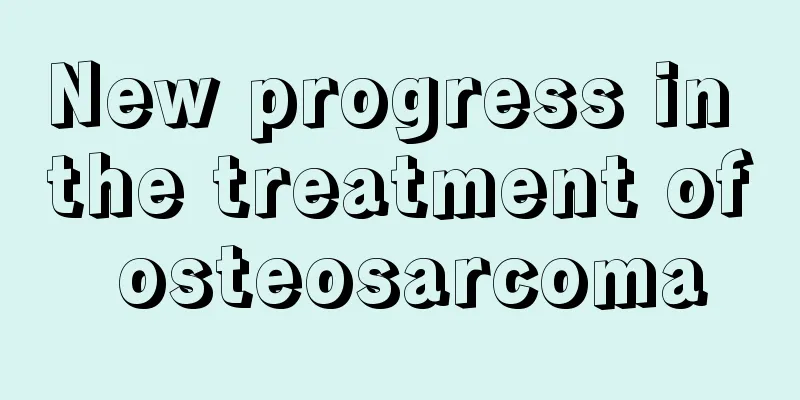New progress in the treatment of osteosarcoma

|
Although there are many methods for treating osteosarcoma, the cure rate of these traditional treatments is still not very high. For this reason, many scholars have conducted relevant research on the treatment of osteosarcoma in recent years. Now the research has made certain progress and also brought good news to the treatment of patients. Let me introduce to you the new progress in the treatment of osteosarcoma. Before the advent of chemotherapy in the 1970s, limb osteosarcoma was mainly treated by amputation. Not only did patients suffer from limb loss and great psychological trauma, but 80% of patients still inevitably died from lung metastasis. When neoadjuvant chemotherapy appeared, the 5-year survival rate of osteosarcoma was greatly improved from less than 20% to 50% to 60%, and more than 90% of limb osteosarcoma patients could receive limb-sparing treatment, using different reconstruction methods to obtain more satisfactory functions of the retained limbs. 1. Neoadjuvant chemotherapy The improvement in the treatment of osteosarcoma is first attributed to neoadjuvant chemotherapy. Rosen proposed the concept of neoadjuvant chemotherapy in 1979, which is to add preoperative chemotherapy on the basis of previous postoperative chemotherapy. Preoperative chemotherapy is beneficial to kill micro-metastases throughout the body, reduce the size of the primary tumor, and make limb-saving surgery easier to implement; postoperative chemotherapy is guided by the postoperative tumor necrosis rate, and limb-saving has replaced most amputations since then. The five-year survival rate of patients without lung metastasis at the time of consultation has increased to about 60%. Therefore, the application of neoadjuvant chemotherapy has become an important milestone in the history of osteosarcoma treatment. At present, the neoadjuvant chemotherapy regimen for osteosarcoma mainly consists of four drugs: high-dose methotrexate (HD-MTX), doxorubicin (ADM), cisplatin (CDP) and ifosfamide (IFO). Patients with effective preoperative chemotherapy have clinical manifestations of reduced pain, increased joint mobility, and reduced circumference of the affected limb; imaging manifestations include X-rays showing a reduction in the tumor range, calcification or ossification at the edge of the tumor, CT and angiography showing a reduction or disappearance of tumor neovascularization, MRI examinations showing a reduction in the tumor soft tissue mass and a clear boundary with the surrounding tissue, and isotope scanning showing that the concentration of radionuclides has significantly faded or disappeared; in laboratory tests, whether alkaline phosphatase and lactate dehydrogenase decrease is also one of the indicators for observing the efficacy; the most important, sensitive, and objective evaluation standard for preoperative chemotherapy is the histological response of the tumor to chemotherapy drugs, which is also the basis for guiding postoperative chemotherapy. According to the histological grading of tumor response to chemotherapy developed by Huvos et al., a tumor necrosis rate of >90% indicates a good chemotherapy effect, and a necrosis rate of <90% indicates a poor chemotherapy effect. Osteosarcoma patients with a high tumor necrosis rate after preoperative chemotherapy have a better prognosis, and the postoperative chemotherapy regimen should be adjusted for patients with poor chemotherapy effects. Limb-Saving Surgery Limb salvage is currently the mainstream surgical treatment for limb osteosarcoma. The principle of limb salvage is that the survival rate of limb salvage is basically the same as that of amputation, and complete resection with wide surgical margins is the key to controlling local recurrence [7]. Most treatment centers now use limb salvage for more than 90% of patients. The most basic requirement for limb-saving surgery is large-scale tumor resection. In principle, a layer of normal tissue is retained in all directions of the tumor. This type of resection is generally a wide resection, and sometimes marginal resection is also possible, especially between the tumor and nerves and blood vessels. In order to avoid residual tumor tissue and intraoperative spread, in principle, the resected tissue should include the tumor and surrounding normal soft tissue, as well as the soft tissue around the biopsy incision, that is, the operation should be performed within the normal tissue to avoid direct contact of the surgical instrument with the tumor. The bone resection level should be 3 to 5 cm away from both ends of the osteosarcoma. This level can be determined based on X-ray films, CT, and MRI. The latest development is the emergence of computer navigation, which achieves more precise resection. Computer navigation technology is now gradually being developed in China. 3. Radiation therapy Osteosarcoma is not sensitive to radiotherapy. Radiotherapy is generally not used routinely. It is only used as a palliative treatment for patients who cannot undergo surgery and temporarily relieve pain. 153Sm-EDTMP is a bone-loving radioactive therapeutic drug that has a good effect on the reduction or disappearance of pain and metastatic lesions. Anderson et al. used 153Sm-EDTMP and 99Tcm-MDP to effectively relieve the symptoms of osteosarcoma patients. At present, the comprehensive treatment of osteosarcoma patients is still mainly based on preoperative and postoperative chemotherapy and surgical treatment. The treatment effect has been improved compared with the past. However, the treatment of osteosarcoma has encountered bottlenecks in recent years, especially for patients with lung metastasis and chemotherapy resistance, which requires the development of new drugs and treatment strategies; while immunotherapy and gene therapy are still in the exploratory stage and are rarely used in actual clinical applications. It is believed that with the progress of clinical research and application of chemotherapy resistance, gene therapy and molecular targeted therapy, new and more effective comprehensive treatment methods will be provided for osteosarcoma patients, and the cure rate of osteosarcoma will inevitably increase gradually. |
<<: What are the clinical manifestations of osteosarcoma
>>: How to overcome the difficulty in diagnosing osteosarcoma
Recommend
How to use a neutral density filter
How should we use this laser mirror? Laser mirror...
Several major factors that induce the occurrence of breast cancer
Women can suffer from a variety of breast disease...
What are the plants that can protect against computer radiation?
For some professional white-collar workers, they ...
What are the taboos of snake meat stewed chicken
Snake meat is a favorite of many people, and stew...
Which hospital is good for treating gallbladder cancer?
Which hospital is best for treating gallbladder c...
Can't I take a shower after a meal?
We generally cannot engage in various activities ...
How long does it take to stop taking medication after osteosarcoma
Osteosarcoma is a malignant tumor disease. If you...
What should I do if rhinitis becomes severe during pregnancy?
Every pregnant woman is very careful during pregn...
How to pick the line of shrimp
Before cooking shrimp, the thread should be picke...
How to promote blood circulation on face?
Nowadays, many friends always have poor blood cir...
If you always have migraines, be careful of these reasons
Nowadays, more and more patients suffer from migr...
Is bladder cancer afraid of drinking more water?
Bladder cancer is a common urinary system tumor. ...
How to wash off dried semen stains
Semen stains refer to the liquid on clothing or s...
What to do if your neck becomes thick after radiotherapy for nasopharyngeal cancer
What should I do if my neck becomes thick after r...
What are the hazards of microcrystalline cellulose to humans?
People often hear about the nutrient cellulose. I...









